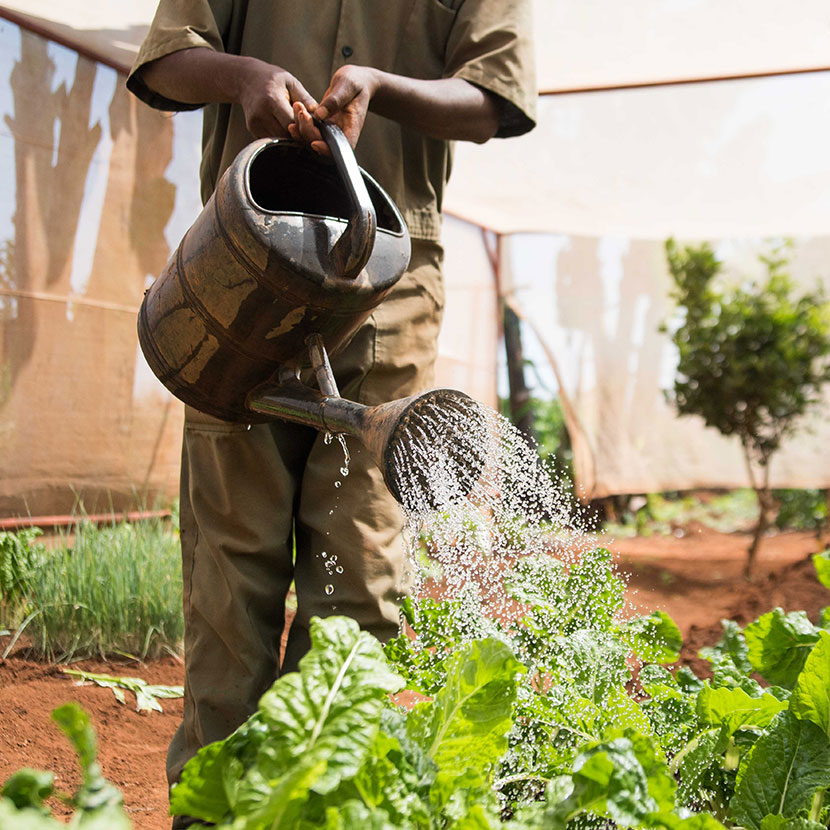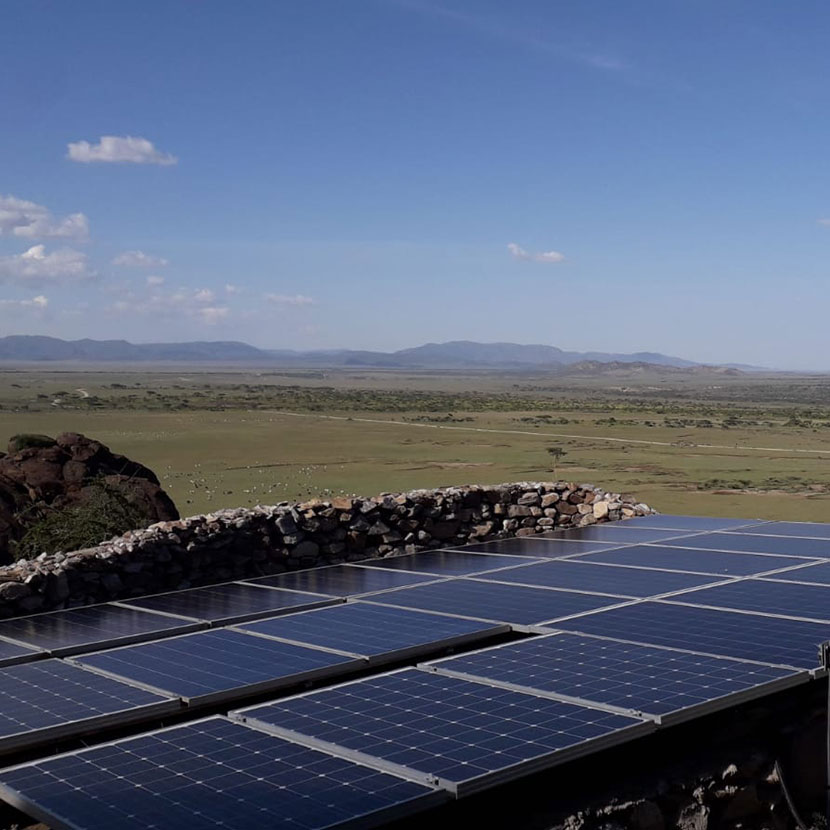Commitment to responsible tourism
- Home
- Commitment to responsible tourism
The protection of wildlife
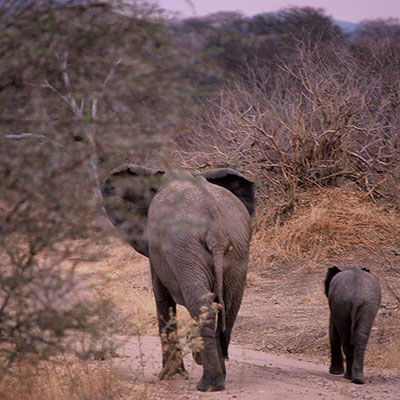
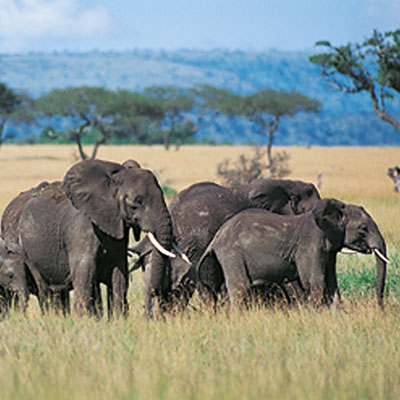
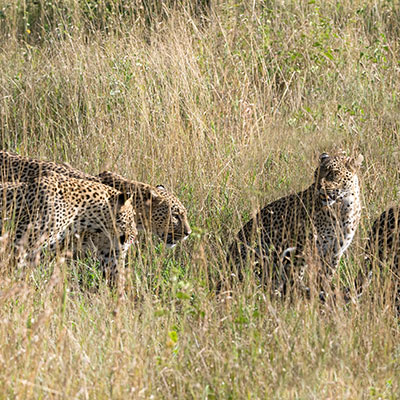
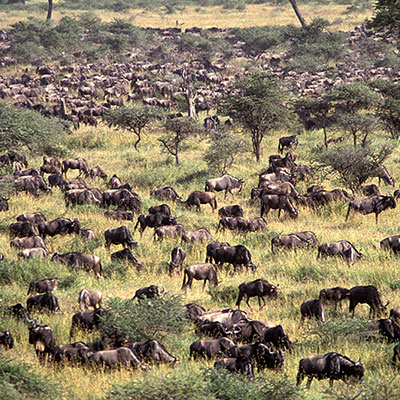
The Wildlife Conservation Foundation of Tanzania aims to protect the unique heritage of Wildlife of Tanzania. One of the unique ecosystems of the world hosts one of the largest concentrations of elephants, making it a prime target for poachers. Just 10 years of this level of poaching would be enough to exterminate the elephant population, albeit the richest in the world. This is a cause that concerns us all, because we are all responsible. The Government of Tanzania assumes sole protection of this common heritage, in the tradition handed down by President Julius Nyerere through his famous Arusha Declaration. It is important to know that with its 12 National Parks and its many Game Reserves ; Marine Parks & Forest Reserves, Tanzania devotes more than a third of its vast territory to the protection of wildlife. It is necessary, and just, to give them our support to save our heritage, to save these endangered species which face extinction. Our mission is to protect those who cannot save themselves, criminally exterminated in the lure of profit.
In 1988, Gérard Pasanisi, who later became Honorary Consul of Tanzania in France and Executive Vice President of the WCFT, obtained from the French Minister of the Environment, Mr. Brice Lalonde, (while France held the Presidency the European Union), a commitment at the conference of CITES in Lausanne to prohibit the ivory trade by moving the elephant to Appendix 1. Thanks to this intervention, the ivory trade in the world was finally banned.
Unfortunately, as of 2007, elephant poaching resumed to then reach dramatic proportions in 2012, 2013 and 2014 that are totally out of control. Every day, the elephants disappear into the culpable indifference of all the international powers combined, having the right to shed tears of good conscience only after it may be too late. If tomorrow the media told you that this giant that leaves its huge imprint on the dusty earth, the African Elephant, had disappeared, that he is no now more than a legend or an animal of the past that we might only encounter in the corner of a museum...
Would you remain indifferent? Men are fighting out in the field to protect them, for us and for future generations, sometimes risking their lives. It is a real Ivory War that is being waged out there. It is not a question of leaving it to those for whom it is a vocation, it is about allowing their action to continue. Thanks to the WCFT, the two main poaching networks in Tanzania but also in Kenya and Mozambique were dismantled. The manifestation of a will to succeed is required to put a stop to this constantly renewing massacre because poaching continues.
The Foundation does not receive any grant, so its independence is guaranteed. It relies solely on volunteers, as well as on close collaboration with the Tanzanian Government, without whom nothing would be possible.
It is exclusively financed by donations made to it, and thanks to the precious support that we solicit.
It is a commitment to the real Ecology and in its sole service.




Support for schools
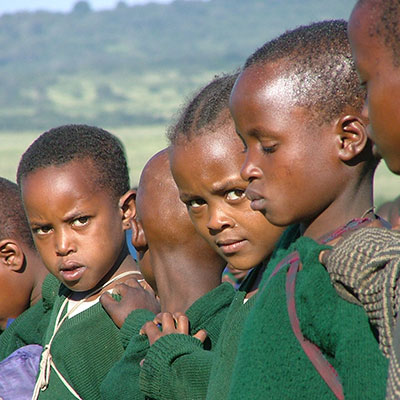
For more than thirty years, we have been involved in viable aid projects with Tanzanian schools. Often, we co-finance these projects with the help of client companies who wish to leave a legacy and a tangible trace of their Tanzania sojourn. Many large and smaller companies have helped finance some quite substantial projects, school and college infrastructure. These achievements range from the construction of schools from the building foundations to the first day of classes, in areas that had no educational facilities at all, to the expansion and upgrading of existing structures – building of classrooms and other school buildings to cope with the recent dramatic increase in school enrolment; projects to improve the lives of students such as supply and distribution of drinking water; renovation of toilets; pathway and playground area rehabilitation, making it easier for students & staff to move about ; canteens; libraries; offices; teachers’ housing; sports facilities ... ) Regarding smaller donations, we buy educational materials like notebooks; pencils & pens; uniforms.. some schools have upwards of 1,000 students and attendance is in 2 ‘shifts’ during the day and a majority of parents cannot afford to pay for the neecessities. It is therefore mostly up to the schools themselves to meet the yearly rising expenses. These donations are often made on the occasion of visits and other less formal encounters between travellers and students, while having a snack or during a ‘Student vs. Guest’ football match!



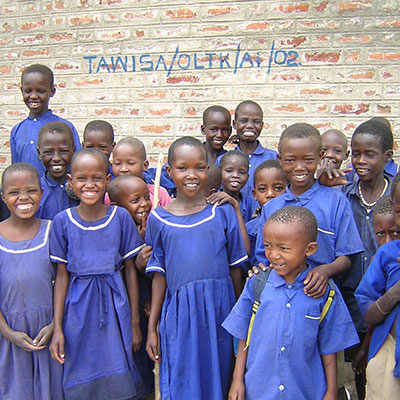
Tree planting
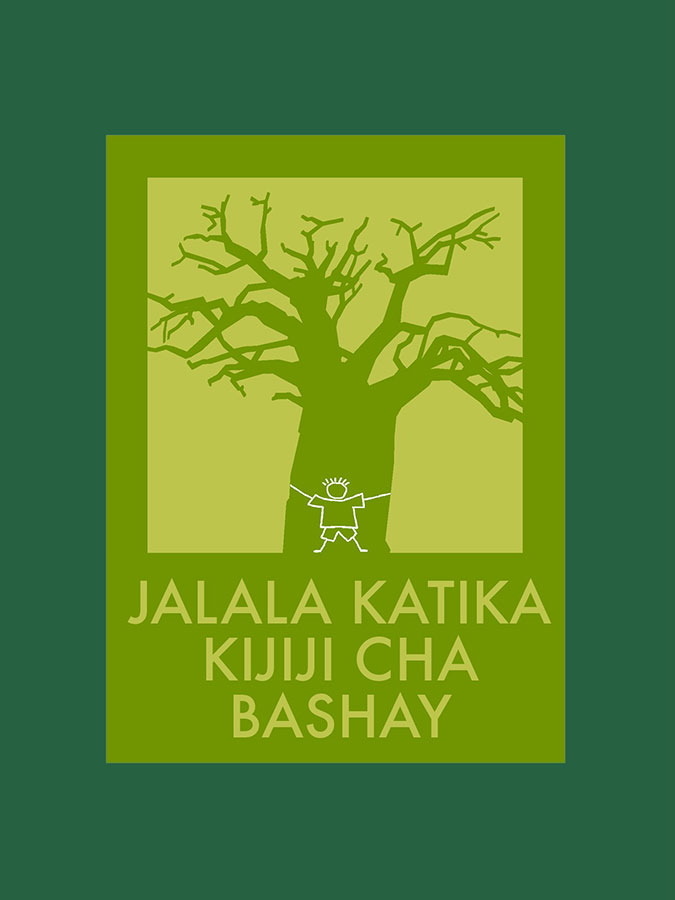


"Hifadhi Mazingira Kijiji Cha Bashay" Foundation:
Nature Heritage of Bashay Village Foundation:
We have all come across a situation where we've said "if ... I do my part to change things". If you had the time, the means, the support needed. That's what happened to us too. In rural villages, people use wood charcoal for cooking. Trees provide this basic need, but Nature takes time to restore its balance. That's why we decided to give Nature a bit of a jump start..
"When you cut a tree, plant another one". This sentence is the driving force behind the project that was born with the Basrah Hifadhi Mazingira Kijiji Cha Bashay Foundation: Conserving the Bashay Villages Environment. In 2012, Denis Lebouteux, the director of MKSC, established the Foundation with Daniel as head. Joined in 2015 by Catherine, they have worked since then together to carry it out. For the task is not small: thanks to their work, 30,000 young tree seedlings have been propagated and replanted by families each year in the entire area of Bashay. Each family is entitled to 20 plants per year, which they get from the Foundation for free. The 973 households of Bashay are listed in Catherine's notebook which keeps a count of the trees given out throughout the year. However, these are not the only beneficiaries of the project: a hospital, three schools and village gardens receive more than 1000 plants per year as well.
The risk with a project like this is that after a while people do not find it interesting and it falls by the wayside. But what's great is, that from the start, all those involved were volunteers for replanting. Having been informed about the project at its outset, the inhabitants came independently and year after year, have been at the heart of suggesting changes to the species planted. Catherine and Daniel take their requests into consideration and adapt their production as far as possible. Between nine and sixteen different species are planted each year.
The main target is timber and wood fuel trees, Olea africana or Grevillea robusta, for example, but there are also trees like Leucaena Leucocephala used to feed livestock, or fruit trees like papaya, avocado, orange and guava.
Moringa seed (Swahili 'mlonge' or sponge), known for its nutritional and medicinal properties, also sometimes responds to the call. Depending on the species, it can take between four months and a year before the plant is ready to be distributed.

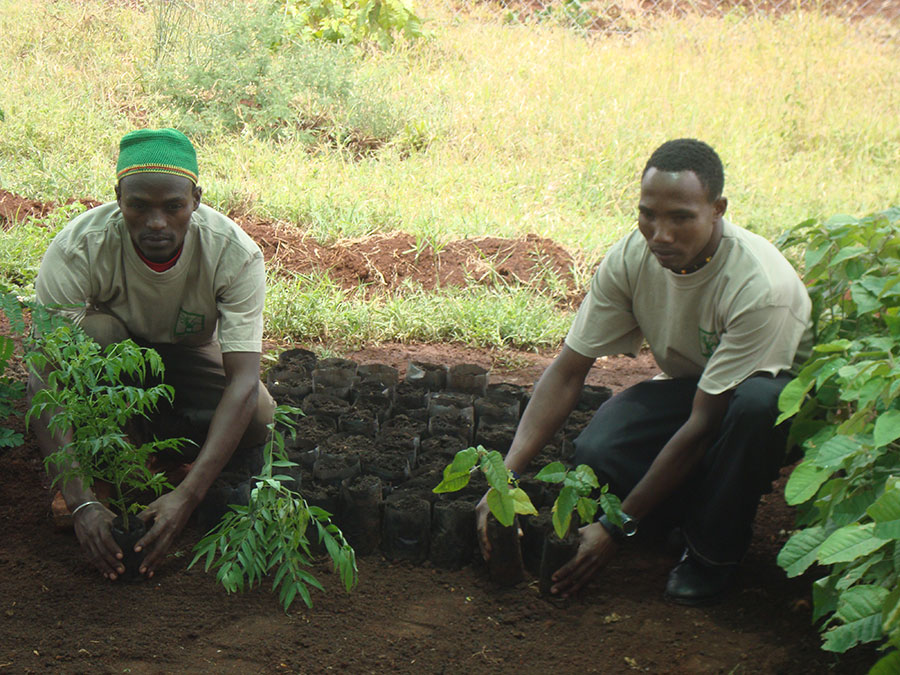
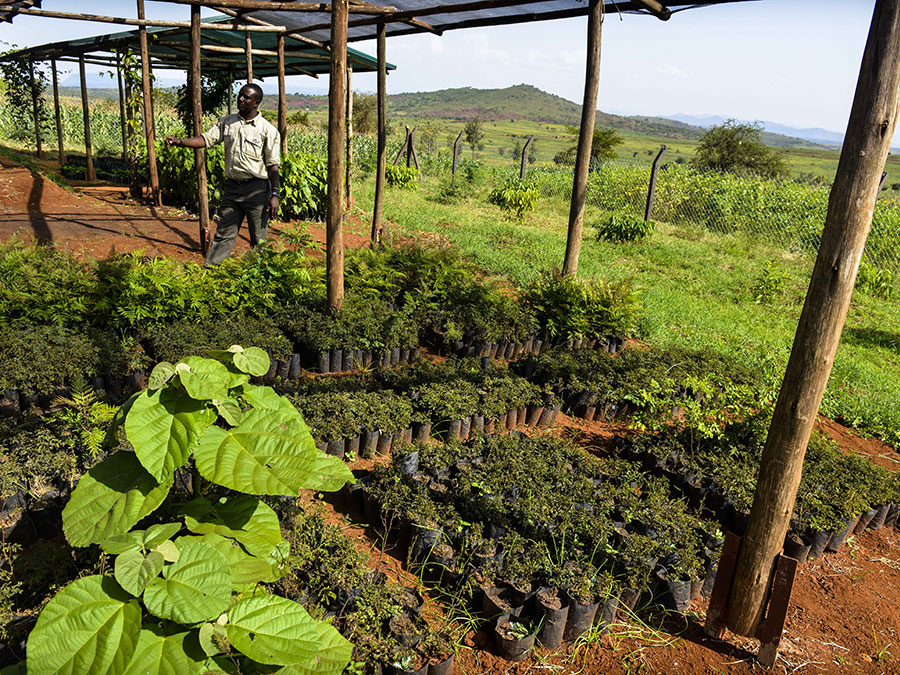
Interview :
Hello Catherine, hello Daniel, can you explain a little bit about your work? What are you propagating right now?
Daniel : We grow our plants in a mixture of mature manure, sand and soil which is all put in polybags. After we water, sometimes adding a natural fertilizer that is prepared with water and manure, and then keep the plants in the shade. We do not have any particular problem growing our trees and we do not use any chemicals.
Catherine : All you can see there are 17,000 plants. We group them by species and at the moment we have ten different ones.
How do you obtain twig cuttings or seeds for sowing?
Daniel : Generally we go three to four consecutive days a month in the bush to find what we need. I have moringa seeds that we brought back not long ago, I can show you them just now. There are only two of us working on this project, besides the guard, so I ask four other people to accompany me and Catherine stays at the foundation.
Do you give training? Do you have visits?
Catherine : Yes, we have students from Rhotia Valley College who come about four times a year for a full day to learn what we do. Then there are groups of 30 to 50 people from overseas, usually Europe or America. We also have young people from a primary school who come occasionally and we raise awareness with them of the importance of trees in conserving the soil and the environment. Just behind you there, you have illustrations on the wall that explain our project; we use them during these presentations, it allows us to better illustrate what we are trying to achieve.
Other than this, we do not have very many visitors, sometimes we receive MKSC guests, but not very often.
We are always happy to receive anyone, so welcome! Karibuni !
Waste recycling
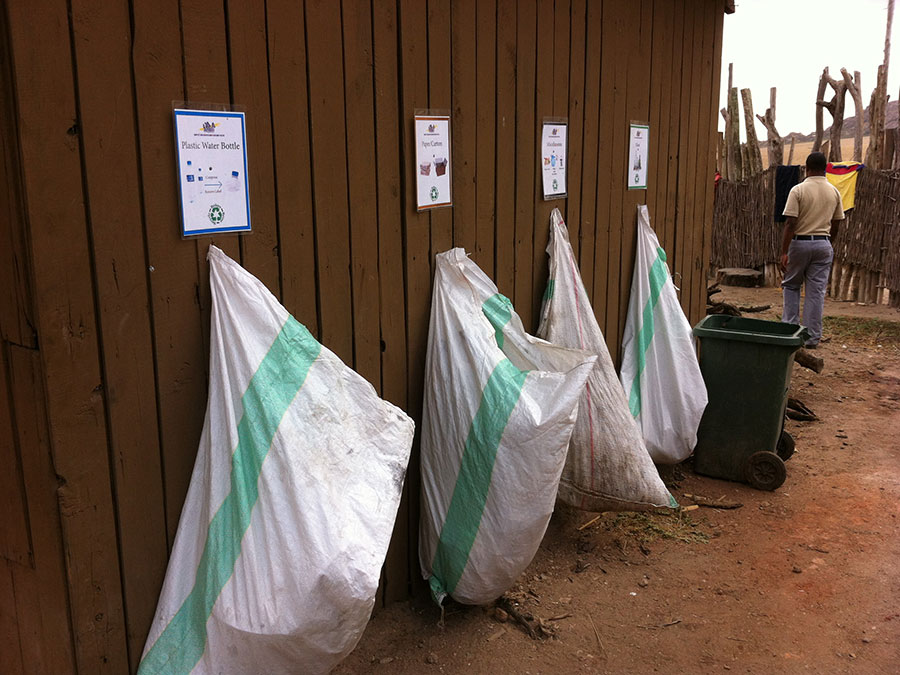
But there is good news under the sun; great recycling solutions exist here too, if we are interested and take time to investigate a little.
In this marathon to transform the obsolete into the useful, the first step is to separate the waste to be recycled. We have set up sorting cages for this purpose in all our camps.
Except for organic waste and metal, regular trips are made out from Camps to our Bashay Rift Lodge to consolidate them. No mystery to this; unlike our other camps, Bashay Rift Lodge is located in an inhabited area and therefore benefits from a municipal dump. A few years ago we decided to buy the land on which the dump is located. At our request, trees were planted along the edges in order to prevent run-off from accumulating. With this decision our involvement extended beyond our company's waste alone. Today we are building relationships with District politicians to rethink waste management on a larger scale.
To return to our recycling journey, this is what happens to our five constituent parts:
At Bashay Rift Lodge, it is in our henhouse that the organic waste of the kitchens is used, enough to give our laying hens enough energy to lay some nutritious and pretty eggs. The glass bottles are partly donated to the Dagueno project in Karatu, a school for girls who have had to leave the national education system for family reasons and no longer have the right to enroll again. These students collect them and turn them into decorative glass objects to sell in their school's shop. As for plastic bottles, we have a partnership with the company Swiss Bottlers that produces them. We take them to Arusha where they will be recycled again into water bottles.
Another interesting waste category to be exploited includes cardboard and paper. We provided a press at the dump to make briquettes. They can be used as a complement to charcoal and used for cooking. Our desire would ultimately be to develop a barter with the local people of the area; they would bring sorted waste to the dump and we would give them briquettes in exchange.
Finally, metal is the last waste that we seek to recycle. We resell what we were able to recover from the camps, as well as what comes from our vehicle workshop in Arusha.
Despite this progress, we are always looking for new partnerships to be formed because this work is not finished, projects and ideas are evolving and recycling solutions are just waiting to be found.
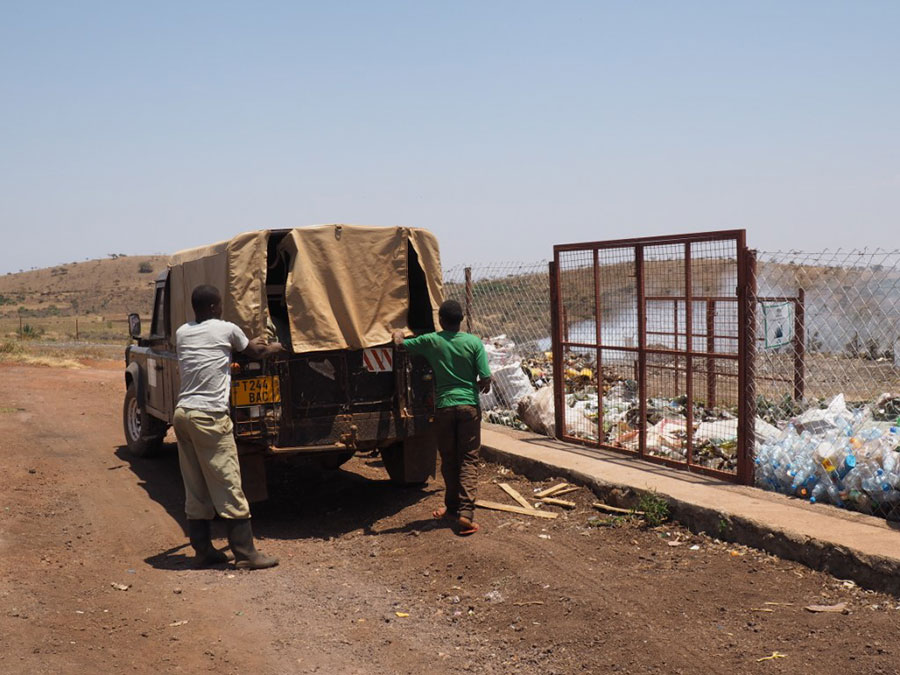
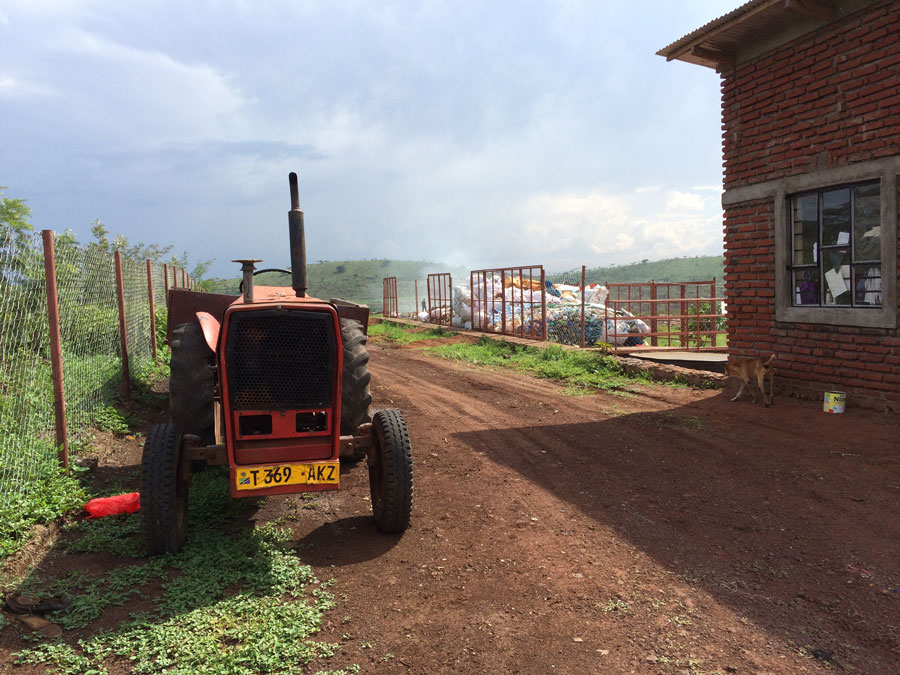

Interview with Pascal, Jumanne and Raphael :
When did you start working here?
When MKSC started to get involved, that is, since September 2014. One of the first things they did was put a fence around the whole area, to prevent the dump from spreading. They also provided sorting cages to be put in place.
How often do you receive waste from MKSC camps?
Every Sunday; there are also about fifty other lodges that drop their garbage here, some of which make the effort to sort too. It makes it easier for us to work, unlike the municipality's truck that comes five times a day to drop mixed garbage. Here we try when we can separate the metal, the glass and the plastic, into the big cages that you see there. This is difficult and dirty work.
If you take the example of plastic bottles, you must receive huge quantities, how do you manage them all?
Before we had problems because the company that was supposed to remove them did not come when expected, so MKSC decided to undertake this as well. When one of their trucks is available and empty, and we have enough plastic bottles to give them, it returns to Arusha to deliver them to Swiss Bottlers. Even if there is no rule, we can say that on average it is done every three months.
We heard that you made cardboard briquettes, can you explain how?
When we receive cardboard, we put it in this big container of water until it's completely full. Once it's full, we take it out and compress it with the pressing machine. We need a full container like this one to make 50 briquettes.
The organic vegetable garden
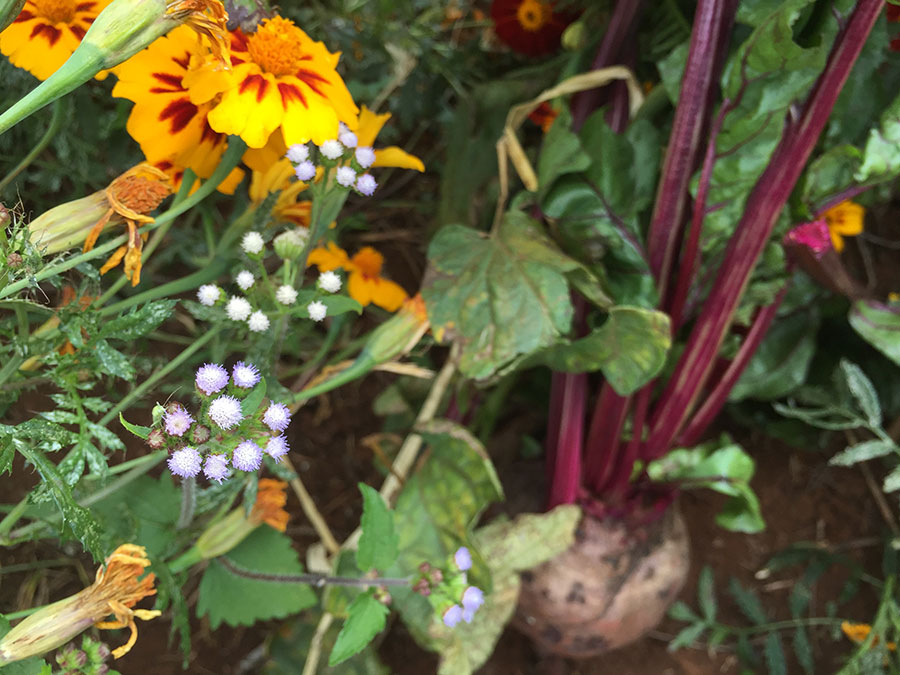

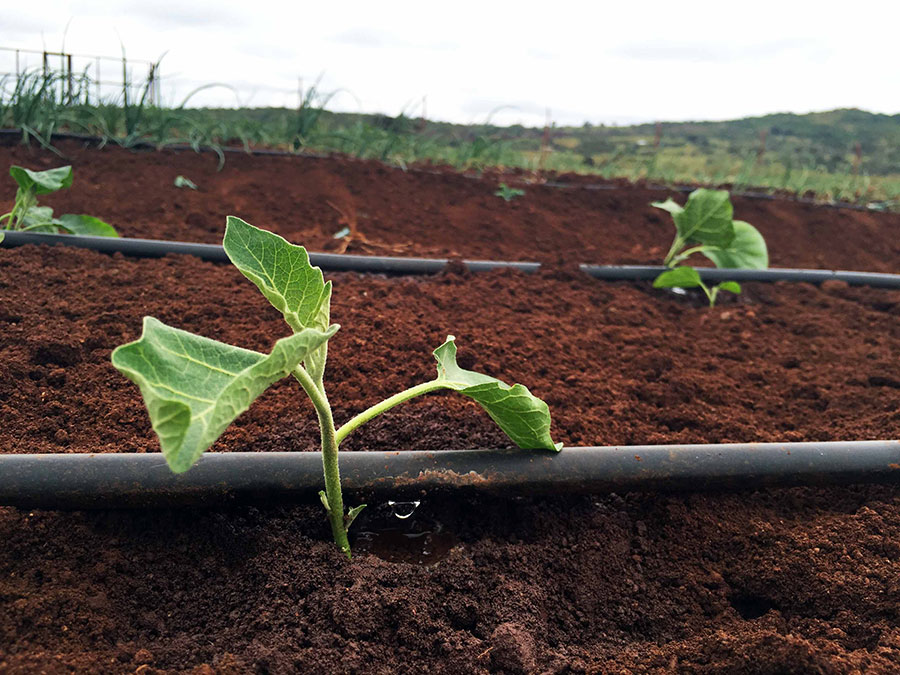


At a time when ecological and health concerns are merging in all areas, "eating" is becoming a central theme. Is what I eat healthy? Healthy for me, healthy for the earth, healthy for the person who produced it? At home we are responsible for the choice of products we cook. But in restaurants, when travelling, in hotels, we put this responsibility in the hands of the host, who usually doesn't know where the cooked food comes from.
The Mount Kilimanjaro Safari Club has chosen to know and control where its vegetables and fruits come from and it makes the decision to keep its guests informed so that you can feel reassured when you join us on the Tanzania adventure. Let us guide you through the history of our vegetable garden with papaya leaves and pepper seeds.
In 2013, MKSC acquired a piece of land at the foot of the mountain to drill a well. Since the land was much bigger than we needed for this use, we decided to plant some fruit trees there. But nature abhors empty space, so more plantations were created on our small piece of land. We enthusiastically planted some of everything, including artichokes and strawberries. After some failures, we finally decided to concentrate our efforts on a smaller number of vegetables and to organize ourselves better. The vegetable garden was born.
From pumpkins to avocados, aubergines, leeks and lemons, our organic vegetable garden now supplies three of our lodges, Olduvai, Maweninga and Bashay Rift, with more than twenty different types of vegetables and fruits. In order to guarantee their freshness, every three days an employee is responsible for picking up the products. With this vegetable garden we want to achieve self-sufficiency with the majority of the vegetables. Therefore we have decided to double the area to 2.8 acres in 2017. We hope that it will then be possible to supply two to three more lodges in the very near future and subsequently all seven lodges.
On the production side, our gardeners work on hillsides with crops that they mulch during the dry season to limit evaporation. Since organic farming is now the norm in our region, no chemicals are used! Gardeners practice crop rotation, spraying natural homemade products, relying on cats that eat mice and nets that prevent birds from pecking at the delicious chard leaves. We are also making progress on the fruit side. Following the tradition of a multi-level permaculture garden, shrubs and banana trees provide shade and shelter for the many birds, passion fruit plants green the metal fences and protect the plants from wind and dust.
To save water, we have installed a drip irrigation system, which allows us to achieve regular production all year round.
To complete the installation there are also compost bins and a nursery where most of the seedlings are prepared under cover.
Growing our own vegetables was a first step for us, but with the desire to go further in order to comply with our principles, we decided to go organic. You can learn more from the interviews with the gardeners who have made this transition.

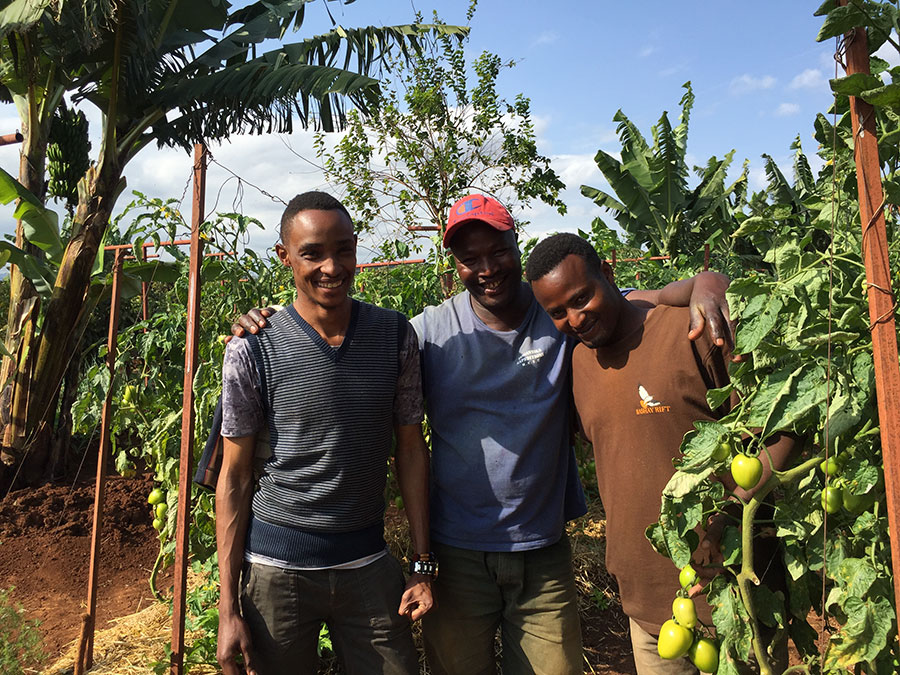

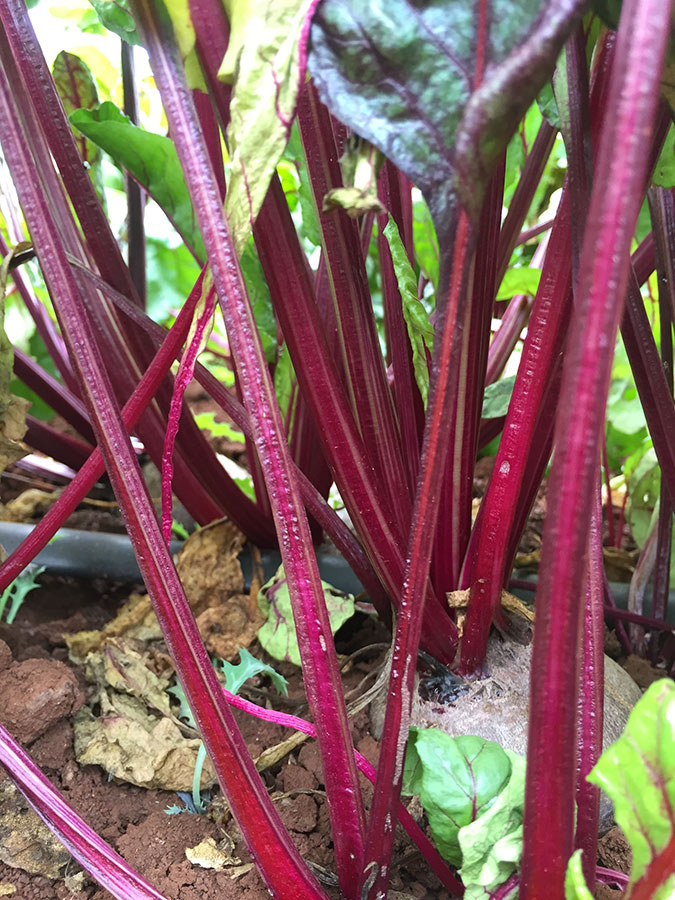
Interview with the gardeners:
Where did the idea of moving to organic production come from originally?:
Julius: When customers were informed of the presence of the vegetable garden, the first question they asked was often "It is organic? " That's where the idea of going into it this approach originated. We were apprehensive before we started, we had never done agriculture without pesticides, but with the management of MKSC, we said "we'll try and if it does not work, we will return to chemicals". The first step was the annual Arusha Agricultural Fair. We stayed there for 10 full days, we learned a lot about organic farming. This year MKSC has also sent us on a two-week training in Permaculture in Morogoro. We have gradually put into practice here what we learned there.
What difficulties did you encounter at first?
Julius: Insects! This is always the main challenge. Almost all the yields went down when we stopped our chemical treatments; especially the tomatoes! But MKSC management continued to encourage us. We started to make our natural treatments, such as nettle manure, to plant carnations, which are repellent flowers against certain insects. Little by little we have learned and progressed.
Emmanuel : The rainy season is also a problem when you are going organic. Before we used pesticide products that limited the cold and other problems that could occur during the rainy season. But with organic, we had nothing, so it was difficult AND it's still difficult!
Which vegetables are you most proud of?
All four: We are proud of them all! But there are vegetables which the transition to organic has not changed, they seem to do as well either with or without chemicals: white cabbage, spinach and aubergine (eggplant). The ones that cause us a lot of problems are tomatoes and green peppers ... and cucumbers too.
Today are you happy with what you have accomplished, by going organic?
Julius : At first we really did not think we would get there, but we were supported and encouraged, so we made the effort and it paid off. Now we have a good production, and without any chemical help. So, yes, I can say that we are happy when we look from where we started off, but it's still difficult.
Do you want to say a word to customers who will read this interview?
Julius : Now you can be sure that when you eat our vegetables at the lodges of Bashay and Maweninga they are fresh and without any harmful toxins or other herbicides not conducive to your health.
Charles : If you spend a night at Bashay Rift Lodge and you have the opportunity to visit the garden, we would be pleased to welcome you and show you our handiwork - Karibu sana!
The Photovoltaic
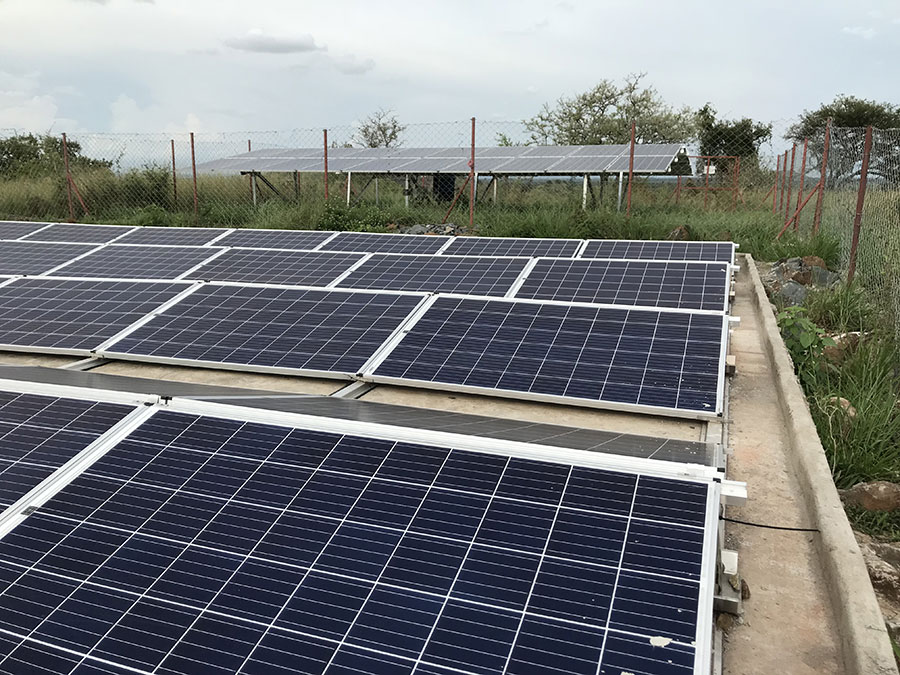
Offering an unforgettable experience in the heart of the Tanzanian natural world has been our number one goal. Our lodges and camps are no exception, situated as they are almost all in the remote areas of the bush. However buffaloes and giraffes were never fond of electric pylons, so how could we offer you a night deep in the savannah, where you could also charge your camera, mobile and have a good hot shower? As our five camps were constructed out of reach of any Tanesco (the national electric supply company) line, the combination of solar thermal and photovoltaic solar panels has allowed us to be self-sufficient, while at the same time constantly respecting and conserving the amazing environment. And what could be more apt than using the African sun to meet this end?
We adapt our facilities to the individual camps. We chose a centralized system at Maweninga Camp and at Ronjo Camp, there is a discreet unit for each tent. At Grumeti River Camp, which is in a specific and very special area and is a base for our entire network, the extensive laundry and the power to charge the unique electric safari vehicles is only boosted by the generator when cloud cover lasts longer than usual.The Bashay Rift Lodge is the only one of our lodges (& Arumeru?) which still relies somewhat on Tanesco but now the generator is no longer the the first option for the frequent cuts and the solar panels have allowed us to reduce the supply by 50% and thus covers 25% of our total consumption.
At last, we have taken advantage of a natural, unlimited and truly ecological "local resource," to replace a limiting and limiting power, polluting and unreliable to boot - kind of obvious, in the end?!
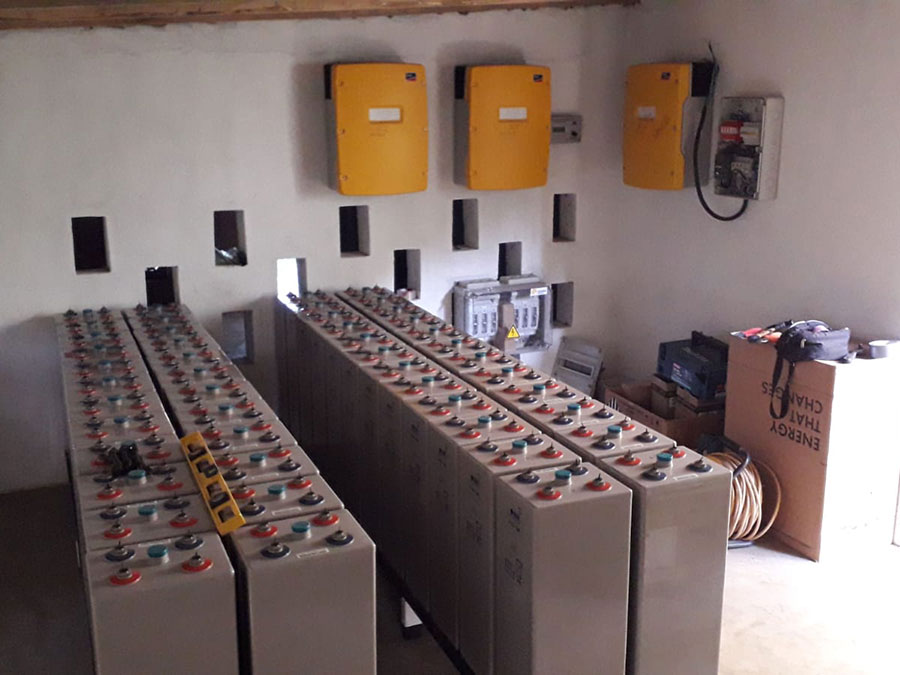

Interview with Harald:
Hello & "Jambo!" Harold, when did you start work at MKSC on the solar panels?
I started in 2013. Since the Camps were set up without any connection at all to the national grid, the solar panels were installed before my arrival as a Consultant. When I started what was already in place was good but since 2013, MKSC has really increased its commitment to the photovoltaic installations, investing totally in equipment and training.
Could you tell us a little about the training?
This is an aspect particularly close to my heart and starts with the MKSC electricians. Training and supervision of these technicians is integral to my role. I also often take Trainees and Apprentices from KITEC (a local technical college) with me; it is vital that young people today learn about green technologies such as solar power. And this can lead to a placement with the company.
Have you thought about what will be done with the solar panels when they are in need of replacement - how are they recycled?
On average,solar panels last 25 years; some batteries 7-10 year and the inverters up to 15 years.The ideal would be to find an appropriate company which does this in Tanzania to avoid overseas transportation and all its implications; for the moment we have a pathway in Arusha. MKSC wanted to find an ecological solution to the electrical constraints which had been faced by their sites and, for the most part, the solar panels themselves are recycling well; better and better. In short,the very first batches of panels, on the market 30 years ago,are now coming to the end of their life. Before it was not attractive economically for a company to enagage specifically in the mass recycling of panels but now the huge increase in demand for materials and to recycle and re-sell is becoming more profitable. Then to complete the ecological approach of MKSC, all the new panels since 2014 are from a CO2 neutral enterprise.
The E-Cars
THE FIRST e.Safari CARS

Mount Kilimanjaro Safari Club launched in June 2018, 2 4x4 safari cars 100% electric and 100% solar. These 2 cars operate daily from Grumeti Hills, safaris (day and night) as well as transfers to and from Fort Ikoma airfield.
Following this successful experience, Mount Kilimanjaro Safari Club transformed 5 new vehicles (between June and September 2019). A fleet of 7 cars in total:
3 E.safari cars based in Grumeti
2 E.safari cars based at Mara River Post
2 electric Toyota pick-ups to supply the camps.
- Frame : Toyota Land-Cruiser, Open Safari Car for Game Drive
- Electric motor
- 44 kW nom, 75kW peak, 3-phases
- Manufacturer : Schwarz, Type AKOE 160.3.2 160 Nm torque from 0-3,500 rpm, max 6,000 rpm
- 110 kg weight
- air-cooled & IP 65 proofed


- Battery : 64 pcs LFMP, 3.2V/200Ah, 6.5kg 96V nom, 416 kg, plus cable, Battery box, fuses, etc. With individual balancing modules on all cells, full BMS, Battery Management System.
- Lifetime
- With DoD (Depth of Discharge) of 70%
- 80% recovery capacity after 8000cycles
- Values at @25°C
- Expected Lifetime = 8-10 years
- Motor Controller : 650 A Curtis 1238-7601 (USA)

- Battery Charger
- A) Zivan NG9 8 kW, 3-phase AC supply, Full Charge in 5 hours, Mounted externally in garage
- B) Onboard Charger, 2.3KW, 1-phase, Full Charge in 18 hours
- DC/DC Converter : To charge 12V board battery : DMC 96 to 12V/900Watt
- Hydraulic pump : for power steering : TRW PA6.6, 12V DC
- Vacuum pump : for brake assist and various controls : Hella UP28, 12V DC
- Deceleration sense : brake lights upon regenerative breaking

- Other Details
- Start-up circuit using original ignition key to engage self-holding relay
- Emergency STOP button to interrupt motor circuit, but leaving power steering and brake assist pumps running
- Forward – Stop – Reverse via electric switch (normally no gear change)
- Typical use & Performance
- Gears : Standard Driving in 3rd gear, Clutch and Gear Box are fully functional but unused
- Consumption : 18- 20 kWh/100 km
- Daily Usage :
- 1 to 3 hours per evening and morning for photo safari for clients from the lodge after dinner/ before breakfast.
- Travel speed around 15-30km/h
- Driving distance= max.20km per 2 hours
- Drive modus: safari, stop and go
- Weight: max. 8 people in total on board.
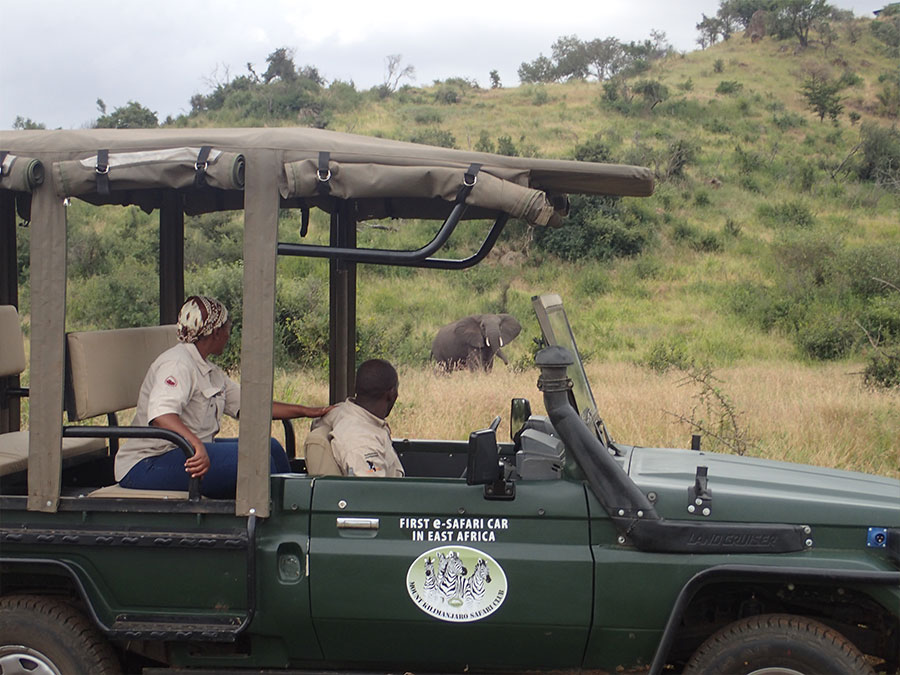


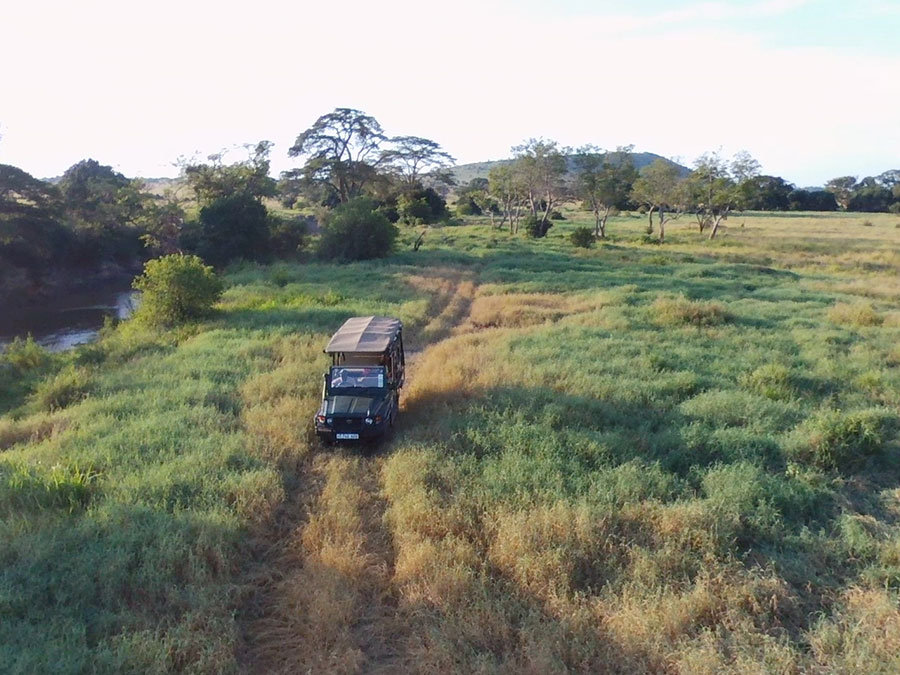
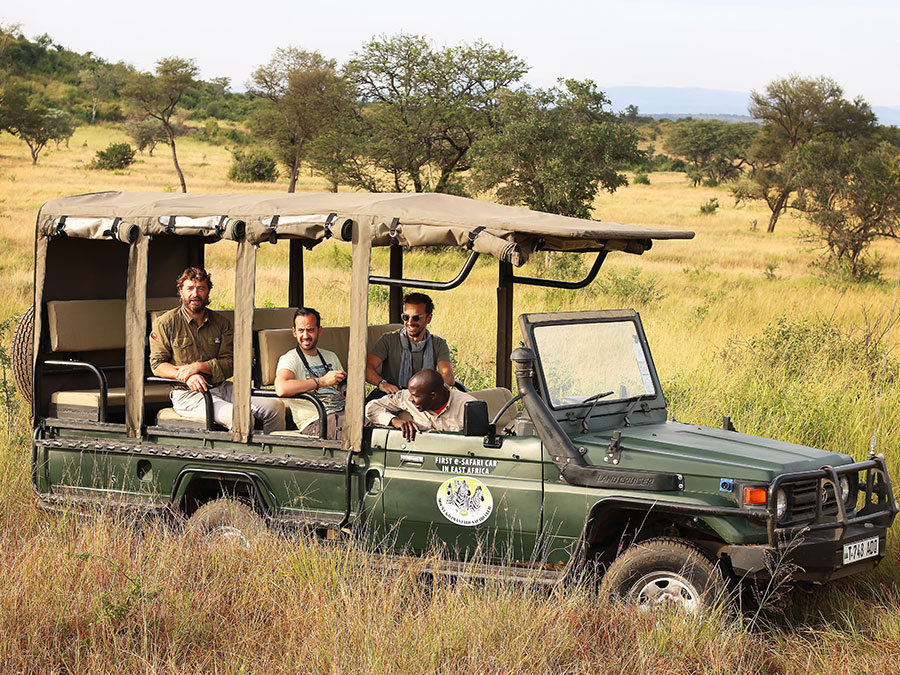
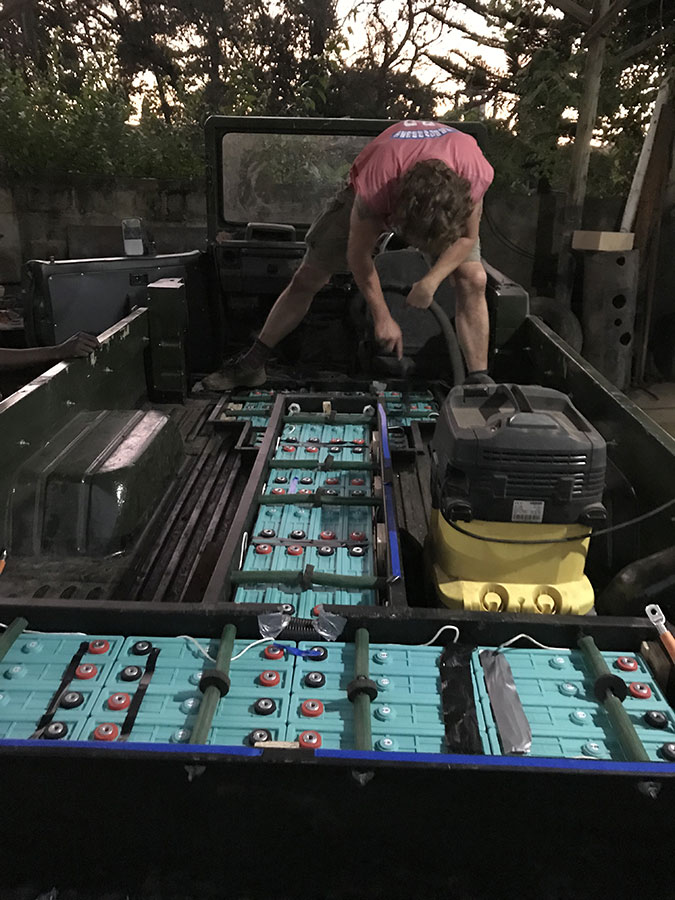
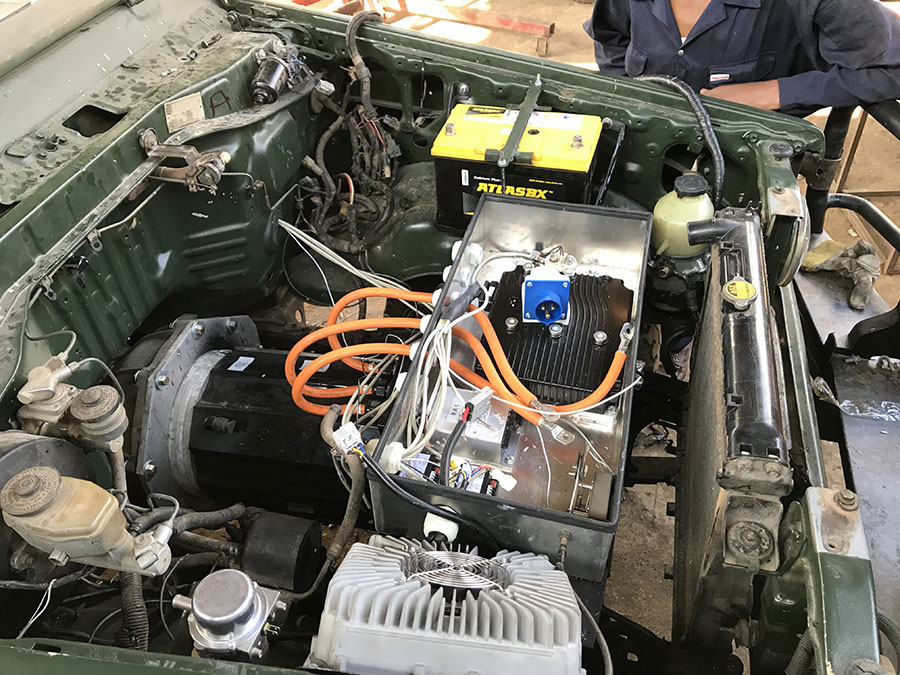
Interview with Denis Lebouteux (MKSC)
How did this project begin ?
Denis : For more than 15 years, we have installed solar panels in our properties. The advance of technology and falling costs helped; we have regularly increased the photovoltaic power installed at our various camps or lodges. Then came the point when we found we were producing more electricity than we needed, especially at Grumeti Hills. We had already linked up to PV, every USAGE possible,(washing machines, dish-washer, refrigerators … etc)
I had read about a Botswana experiment with electric-powered safari cars. Harald, our German engineer then put me in contact with a start-up from Bavaria, (Fleck Technologies) who converted cars of any type into electric cars. So we started off with two cars that have been operating since 24/06/18.
What is the range of these cars?
Denis : This is, of course, problem No. 1. We are used to cars having a good range. With the electric car, we must ask ourselves the right question: a car, for what purpose exactly?
Depending on the particular demands of the day's excursion, we can switch to an electrical solution or we can stay with conventionally powered vehicles (for the moment at least – technology is moving forward!)
The usage of the first 2 cars is short game drives (day and night) and transfers to/from Grumeti Hills. So it was decided that a range of 130km is more than enough to safely cover this.
Is this technology not too sophisticated to adapt to such remote areas?
Denis : We could think so. In fact, it's the opposite. This technology is very simple compared conventional engines. These electric cars require about 40 components, while conventional technology requires hundreds.
Moreover, the latest generation of conventional models, with all its attendant electronics on board, cannot hope to survive long in our remote parts.
Electrical technology is much more basic than the combustion engine.
In 1880, a French engineer drove the first electric car...
A criticism often heard, electric vehicles are not as ecological as they claim?
Denis : First of all, these cars are actually recycled! These first 2 reconditioned Toyota vehicles were over 20 years old, earmarked for scrap. Recycling remains the No.1 tool against overconsumption and CO² production.
Secondly, these cars are recharged with solar power (100%). This is a totally different context from, say, German or USA electric cars that recharge from power sources running from coal fueled power plants.
There remains the problem of the batteries. These should last about ten years, (I think we will do better) with the possibility of giving them a second life as storage for lighting in the properties. For information, the batteries of conventionally powered safari cars do not last much more than 8 months, on average because of the frequent "stop and go" nature of a photographic safari.
Finally, when we look at the fuel consumption of 4x4 conventional equivalents, it comes to between 15 and 18L per 100km.
These 15 to 18 litres are just the tip of the iceberg, we need to include the amount consumed to transport from ports and distribution points to the consumer at the service stations & storage areas as well as the consumption on trips to/from the pumps: in the case of Grumeti this is 50km one way! And it should be said we are not in the worst position by any means.
Will you continue in this direction ?
Denis : It's obvious. I have already planned the modification of 5 more vehicles for 2019. The technical challenges exist, the utilisation marked out for these 5 new cars is different and so require their own unique technical solutions.
Beyond this experience specific to MKSC, I especially want to share it with my colleagues in DMCs & agencies.
We are talking about hundreds of vehicles in the short term.
Tanzania can quickly & readily switch to electric for a large part of its fleet: there are plenty of old vehicles and there is plenty of sunshine … The technology exists, is advancing and costs will continue to go down.
Recovery of rainwater

Rainwater Harvesting

Water is one of the important challenges in the management of our camps and lodges. Most sites do not have wells or other water sources nearby, either because there is not a viable water table or because the quality of the water is poor. The majority of the water table in the Serengeti/Ngorongoro Conservation Area is very high in minerals due to ancient and recent volcanic activity. This type of water causes premature damage to plumbing and equipment such as water heaters. The most traditional solution is to transport water purchased from rural water supply by bowser to the sites, bringing with it significant financial and ecological costs, especially as water points of acceptable quality are quite distant. On the other hand, water is often scarce in some areas, so naturally, priority is given to local needs (population ; livestock) and the camp operator may have to source water from even further afield. This is how the idea of turning to rainwater for a solution came about.
On average, Paris gets more than 640 mm of rainfall per year, while areas like Grumeti or Mara receive more than 1 metre per year. Of course, the rains are much more seasonal in our regions. MKSC has therefore been equipped with sufficient catchment and storage solutions to guarantee partial autonomy (80% at Mara River Post) in rainwater on our facilities. The goal is to limit the frequency of trucks going back and forth.
Collection: All recent constructions were planned from the start to facilitate the harvesting of rainfall. In addition, large funnels of sheet metal over thousands of square metres are in use on hillsides to recover water.
Storage: The older established sites were able to build cisterns large enough to keep them going even over the driest summers. We built tanks - the largest ones are 150,000 litres – well protected from light and able to keep the water pure for several months.



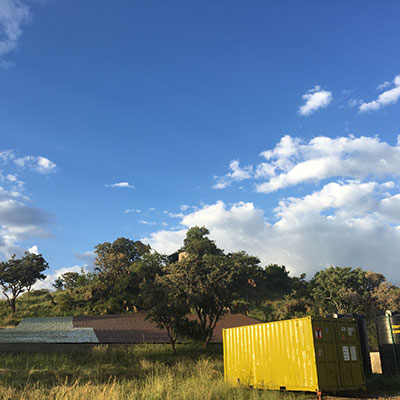
Reduction of plastics
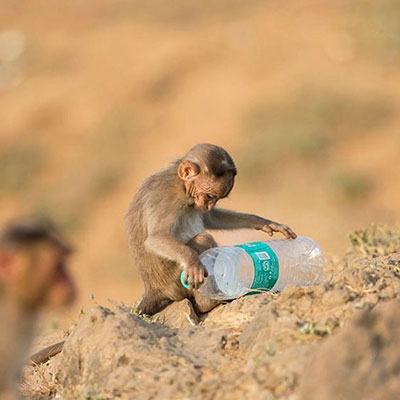
It's a frightening observation, today, a customer, in one week, consumes more than twenty small 50 cl bottles of water to which are added the one and a half litre bottles...
Recycling channels for empty bottles exist but only absorb a small minority of these bottles. The rest unfortunately ends up on the roadside, in open dumps, burnt, scattered by the wind...
This invasion of plastics is here, as elsewhere, a subject that we must try to treat as best we can.
New technologies in water treatment exist, it is up to us to take advantage of them and offer our customers water of sufficient quality and "plastic free".
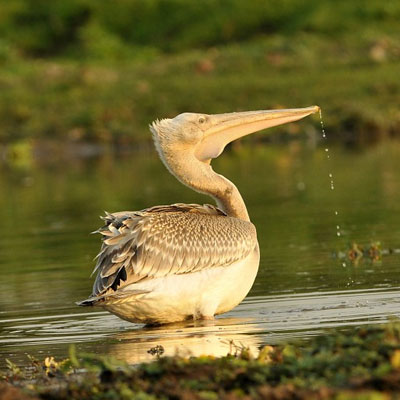

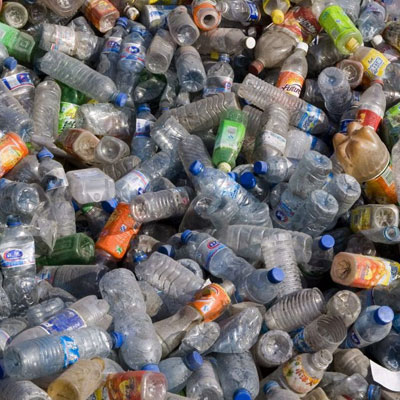

Interview with Yetro Kimei (Manager of Bashay Rift Lodge, MKSC)
Since the end of 2018, guests at Bashay Rift Lodge have been served filtered water both in the restaurant and in the rooms, instead of commercially producted water in plastic bottles. Why this change?
MKSC has long been committed to responsible tourism. It has developed a coherent policy in this respect, which includes waste treatment, rainwater harvesting, the use of electric vehicles, the development of an organic vegetable garden and support for local communities.
However, we found that plastic water bottles represented a considerable volume that was difficult to process in the absence of recycling capacity in the region. Replacing plastic water bottles with filtered natural water seems the ideal solution - especially since at Bashay Lodge, we have good quality natural water. Of course, we have had to proceed in stages: checking the quality of the water; purchase of a filtration system; testing first in the laboratory and then acceptance by the guests.
How did the guests react?
Very positively. We suspected that this would be the case, because more and more of the guests who visit Tanzania, especially on safari, put respect for the environment at the top of their concerns. This is also true of the travel agencies we work with. The abandoning of plastic bottles is therefore very strongly supported by both our partners and our guests. What's more, they appreciate the quality and taste of our natural water. Of course, guests who wish to can still order bottles of water.
What is the impact of this change?
We found in Bashay a 70% reduction in the consumption of bottled water. By the end of the year, tens of thousands of plastic bottles will have been saved and will not need to be recycled.
What are the next steps?
Rolling out to other MKSC camps is underway. After checking the quality of the water supplied in situ and recognising that some are in very dry areas, procedures for filtering and supplying all our camps will soon mean filtered natural water is available at all sites. This is already the case at Grumeti Hills Lodge, which, in addition, has set up an integrated system for collecting and filtering rainwater.This is also true for the most recently opened camp, ‘Olduvai Ndogo.’
By the end of 2019, all camps will be using quality filtered water and will have greatly reduced their use of plastic bottles.
What's more, we are thinking of ordering and offering to each of our guests a re-usable water bottle at the beginning of the stay. This will keep fresh water for their daily consumption, ‘waste-free!’.

